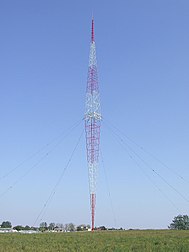Lakihegy transmitter
|
Lakihegy transmitter
Lakihegyi rádióadótorony
|
|||||||||||||||||
|---|---|---|---|---|---|---|---|---|---|---|---|---|---|---|---|---|---|
| Basic data | |||||||||||||||||
| Place: | Szigetszentmiklós -Lakihegy | ||||||||||||||||
| County: | pest | ||||||||||||||||
| Country: | Hungary | ||||||||||||||||
| Coordinates: 47 ° 22 ′ 23.5 ″ N , 19 ° 0 ′ 17.3 ″ E | |||||||||||||||||
| Use: | Telecommunications mast | ||||||||||||||||
| Accessibility: | Transmission mast not open to the public | ||||||||||||||||
| Mast data | |||||||||||||||||
| Construction time : | 1933 | ||||||||||||||||
| Operating time: | since 1933 | ||||||||||||||||
| Last conversion (mast) : | 1944-1948 | ||||||||||||||||
| Total height : | 314 m | ||||||||||||||||
| Data on the transmission system | |||||||||||||||||
| Last modification (antenna) : | 2006 | ||||||||||||||||
| Last modification (transmitter) : | 2006 | ||||||||||||||||
| Waveband : | LW transmitter | ||||||||||||||||
| Send type: | EFR | ||||||||||||||||
|
|||||||||||||||||
| Position map | |||||||||||||||||
|
|
|||||||||||||||||
The Lakihegy transmitter is a transmission tower near Szigetszentmiklós on the Danube island of Csepel in Hungary .
history
The transmitter was built in 1933 according to the plans of Károly Massány as a Blaw-Knox - self-radiating transmission mast with a height of 314 meters south of the Hungarian capital Budapest . At the time of its construction it was the tallest structure in Europe and the tallest steel structure in the world. Today he is in Hungary under monument protection and is still one of the tallest buildings in the country.
The transmitter mast was blown up on November 26, 1944 by the German Wehrmacht fleeing from Southeast Europe as part of the scorched earth strategy . The system was only rebuilt in 1948 and until 1977 the system broadcast the "Budapest I" radio program. It was completely overhauled in 2006 and has been used to transmit the European radio ripple control signal (EFR) ever since .
technology
The transmission mast, like all self-radiating transmission towers, is operated under high voltage . As of 2012, the mast will be used as a reserve for the Solt transmitter on the transmission frequency 540 kHz with 150 kW and in diplex mode to broadcast the European radio ripple control signal (EFR) on 135.6 kHz with 100 kW.
It has a fish belly-like cross-section which is known as the Blaw Knox transmission tower . This type of mast, which is widespread in North America, is only used in Europe for the transmission masts in Lisnagarvey in Northern Ireland , in Wakarel in Bulgaria and Stara Sagora (both in Bulgaria). In addition, there are two other small guyed transmission masts for medium wave of the usual type in Lakihegy.
Another transmitting antenna, consisting of two free-standing towers at 47 ° 22 '25.4 ″ N , 18 ° 58 ′ 59.7 ″ E , is fed from the transmitter building via a 2.1 km long trap line . In addition, there is a guyed steel truss mast for the frequency 873 kHz on the transmitter site.
In 2006, long-wave operation for the ripple control signal of the European radio ripple control (EFR) began broadcasting on the transmitter . This signal is used for the automatic and cross-border remote control of consumers in the supply network of several Central European energy supply companies. The long wave frequency of 135.6 kHz with a transmission power of 100 kW is used for this . The digitally coded control data are transmitted at a symbol rate of 200 baud according to the communication standard IEC 60870-5 .
Guys in the middle of the mast with guy insulators
Individual evidence
- ↑ International radio and television chronicle ( Memento from September 29, 2007 in the Internet Archive )
- ↑ Europe's boldest antenna construction (PDF; 4.8 MB) Publication on the website of the Deutsches Museum . Retrieved June 2, 2013.
Web links
- Lakihegy transmitter. In: Structurae (first Lakihegy transmission tower)
- Lakihegy transmitter. In: Structurae (Second Lakihegy transmitter mast)
- Lakihegy transmitter. In: Structurae (Lakihegy third transmission tower)





